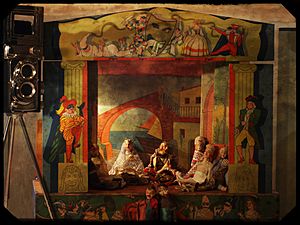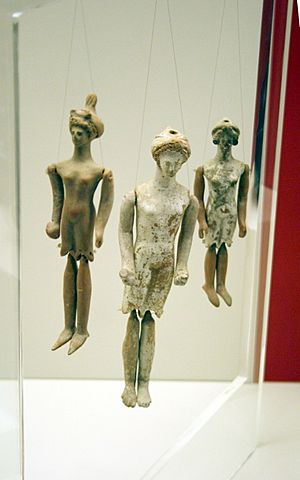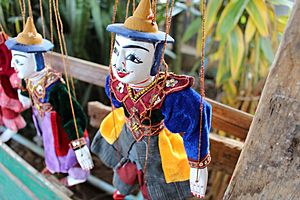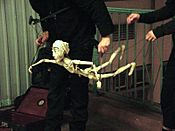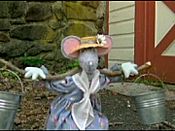Marionette facts for kids
A marionette is a special kind of puppet. It is controlled from above using strings or wires. The person who makes a marionette move is called a marionettist. Marionettes can perform in theaters, movies, and on TV. Sometimes the puppeteer is hidden, and sometimes they are seen by the audience. The way the strings are attached changes depending on what the puppet needs to do.
Contents
What's in a Name? The Word "Marionette"
The word marionette comes from French. It means "little Mary." In France, during the Middle Ages, string puppets often showed stories from the Bible. The Virgin Mary was a very popular character. This is how the name "marionette" came about.
In France, marionette can mean any type of puppet. But in most other places, it only means puppets controlled by strings.
A Look Back: History of Marionettes
Ancient Puppets: How It All Began
Puppetry is a very old way of performing. Some people think puppets might even be older than human actors! There is proof that puppets were used in Ancient Egypt around 2000 BC. People used string-operated wooden figures to show actions like kneading bread.
In Ancient Greece, people also used puppets. The oldest writings about puppets are from the 5th century BC. The Greek word for "puppet" means "drawn by strings." Even famous thinkers like Aristotle and Plato wrote about puppets. They compared how animals move to how puppets work.
In ancient Greece and Rome, small clay and ivory dolls were found in children's tombs. These dolls had arms and legs that could move. Some had a metal rod sticking up from their heads. This rod was used to make the doll move from above, just like some puppets today. Some experts think these were just toys because they were so small.
Sicilian Marionettes: Knights and Heroes
In Sicily, donkey carts are decorated with colorful scenes from old French poems. These same stories are told in traditional puppet theaters. They use handmade wooden marionettes in a style called "L'Opera deî Pupi." This means "Opera of the puppets." These puppet shows tell tales of brave knights, like those from The Song of Roland. You can still see these amazing shows in places like Palermo, Sicily.
Marionettes in Opera: A Grand Performance
In the 1700s, some operas were written just for marionettes! Famous composers like Mozart, Gluck, and Haydn created music for these puppet shows. Even Lewis Carroll, who wrote Alice in Wonderland, made marionette operas for his family.
Today, the Salzburg Marionette Theatre in Austria still performs full operas using marionettes. The Sicilian "Opera dei Pupi" is so special that it's recognized as an important part of human culture.
Modern Marionettes: On Stage and Screen
Marionettes are sometimes just called "puppets." But "marionette" is more exact. It helps us tell them apart from other puppets, like hand puppets or shadow puppets.
In the UK, the The Harlequin Puppet Theatre is the only theater built just for marionettes. It opened in 1958. Other theaters, like the Little Angel Theatre in London, also put on marionette shows. The Puppet Theatre Barge performs with long-string marionettes all year round.
In Austria, the Salzburg Marionette Theatre was started in 1913. It performs operas like The Magic Flute using marionettes. These shows are for adults, but children are welcome too.
The Czech Republic has a long history of marionette theater. The National Marionette Theatre in Prague often performs Mozart's Don Giovanni with marionettes.
In the United States, many groups keep marionette performances alive. The Bob Baker Marionette Theater in Los Angeles is a famous historical place. The Puppetworks theater in New York has been open since 1980. The Center for Puppetry Arts in Atlanta helps new marionette performers.
Marionettes on TV and in Movies

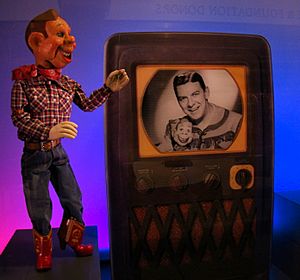
Marionettes became very popular in children's TV and movies. The story of Pinocchio, especially the 1940 Disney movie, is about a marionette who wants to be a real boy. In 1947, Howdy Doody brought marionettes to TV. Howdy Doody, the main character, was a marionette.
In the UK, the BBC made many marionette shows for children. Shows like Andy Pandy and Muffin The Mule were very popular. Later, in the 1960s, Gerry Anderson created hit series like Thunderbirds. He used a special technique called "supermarionation." This combined marionettes with electronics. It allowed the puppets' mouths to move by radio control. These shows became famous worldwide.
Marionettes have also appeared in movies for older audiences. The 1999 film Being John Malkovich features a character who controls people like marionettes. The 2004 movie Team America: World Police used a funny, rough style of supermarionation. The creators called it "Supercrappymation" because they purposely left the strings visible.
How Marionettes Are Controlled: Types of Bars
Chinese/Asian Paddle Control
This control uses a flat, rounded paddle with a short handle. Many strings are attached to the edge of the paddle. The puppeteer picks and pulls each string with their other hand to make the puppet move.
Horizontal Control
This control is a bar held flat in the hand. It can have other bars sticking out at right angles. These bars connect to the puppet's hands, shoulders, or back with wires. A smaller plate usually hangs below the main bar for the head strings. A clip often holds a separate bar for the legs. This style is common in the USA for human figures. It's also used for animal puppets, as rocking the bar makes their legs move together.
Vertical Control
This control is an upright bar. It has smaller bars sticking out at right angles for the head, shoulders, and back strings. This control often has a separate leg bar. The puppeteer holds it in their other hand to make the puppet walk. The arms are controlled by wires that stick out from the main bar. Tilting the main upright bar gently moves the puppet's head and body. This is often called the British control.
Another vertical control style, common in Europe, has a stiff wire rod going from the puppet's head directly up to the control bar. The leg bar can pivot on a pin to allow leg movement.
Different Kinds of Marionettes
Sicilian Marionettes
Sicilian marionettes are some of the easiest to use. They are usually carved from wood. A strong rod goes up through the puppet's body into its head. This rod, along with one string attached to a hand, controls the puppet's movements.
Czech Marionettes
Czech rod marionettes are similar to Sicilian ones but more complex. They are often carved from lime wood. Like Sicilian marionettes, they have a central rod. But they also have strings for the arms and legs. Some even have strings to control a moving mouth or ears. These puppets need more skill to operate. Some Czech marionettes have no central rod at all. Their strings are attached to the head, shoulders, and back. These are the hardest to control.
Burmese Marionettes
Burmese marionettes are all controlled by strings. They are a popular art form in Burma (Myanmar). These marionettes are called Yoke thé, meaning "miniatures." They almost always perform in operas. A Burmese marionette group needs 27 characters. These include a king, animals like horses and monkeys, ministers, and a prince and princess. A traditional Burmese orchestra usually plays the music. Burmese marionettes are very detailed. Male characters have 18 strings, and female characters have 19. Each puppet is controlled by just one puppeteer.
Gallery
Images for kids
-
A Calabash puppet
See also
 In Spanish: Marioneta para niños
In Spanish: Marioneta para niños


